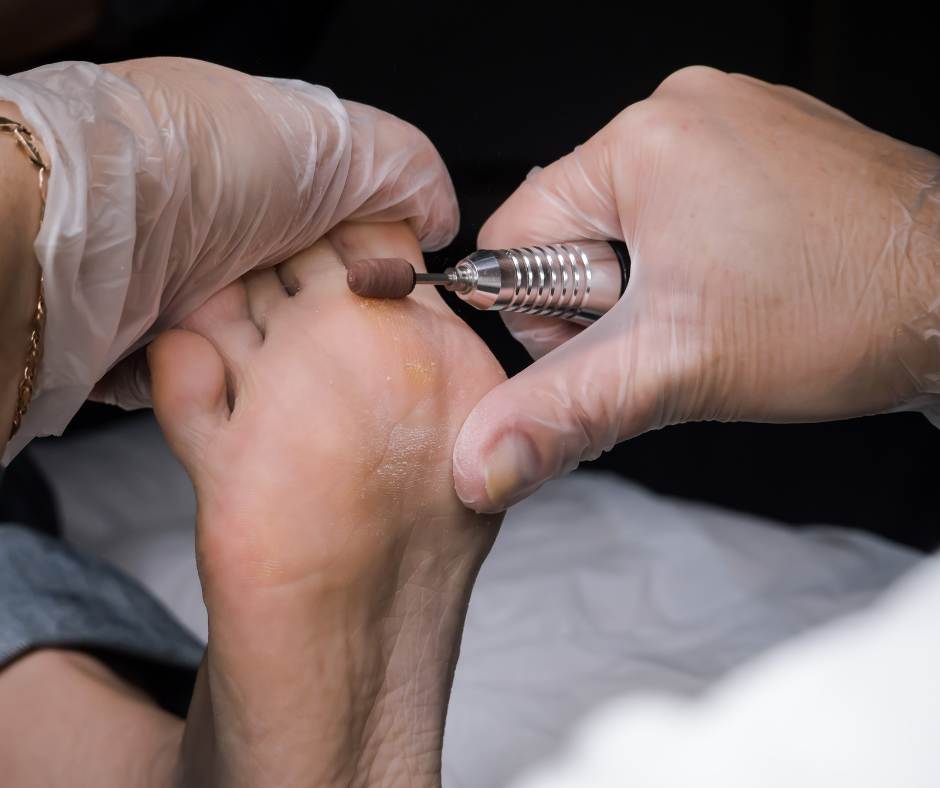Foot Corns & Callus Treatment
Corns & Callus

Table of Contents
What Is A Foot Callus & Why Does It Develop?
A foot callus is a thickened area of skin that forms on the bottom of the foot. It develops as a natural response to repeated pressure and friction. This thickening helps protect the skin and reduces the risk of breaking, which could lead to infections.
However, when calluses become too thick, they can cause discomfort and pain. The extra pressure can affect the tissues, joints, and bones underneath. Since callus is made of dead skin without nerve endings or blood, removing it is usually painless. It’s a simple process, much like cutting your hair.
What Is A Corn?
A foot corn is a thickened area of dead skin, similar to a callus, but with key differences. Corns form at specific points, usually small (2mm–20mm), and grow deeper into the skin in a cone shape. This deeper growth makes them more painful, especially on weight-bearing areas of the foot.
Corns can also develop between the toes due to friction. When this happens, they absorb moisture from sweat and become “soft corns.” These are softer and whiter than regular corns. The surrounding skin is more delicate, so extra care is needed to remove them safely.
Visit Us Today
Hope Island
Phone: 07 5510 9222
Located within Hope Island Marketplace Medical & Skin Clinic, 99-103 Broadwater Ave Hope Island QLD 4212
Jimboomba
Phone: 07 5546 9766
Located Within Jimboomba Medical Centre, Unit 1/69 Cerina Cct, Jimboomba QLD 4280
Beenleigh
Phone: 07 3287 2224
Located Within Beenleigh Mall Medical Centre, Shop24A, 40/68 Main Street, Beenleigh QLD 4207
Eagleby
Phone: 07 2889 1666
Located Within Eagleby Family Practice, 5/120 River Hills Rd, Eagleby QLD 4207
Harristown
Phone: 07 4635 6111
Located Within Toowoomba Medical Centre, 146 Drayton Road, Harristown QLD 4350
Marsden
Phone: 07 3067 2370
Located Within Marsden Family Doctors, Shop 28/55-77 Chambers Flat Rd, Marsden QLD 4132
Keperra
Phone: 07 3355 4082
Located Within Keperra Medical Clinic, 14 Dallas Parade Keperra QLD 4054
Coomera
Phone: 07 5573 5663
Located Within Doctors @ Coomera Central, Shop 6, 21 Coomera Grand Drive, Upper Coomera, QLD 4209
Newtown
Phone: 07 4633 8700
Located Within Ochre Medical Centre Wyalla, Shop 20, 238 Taylor Street, Newtown QLD 4350
How Are Foot Corns & Calluses Treated?
Corns and calluses on the bottom of your foot can be quickly and painlessly treated by your podiatrist in one visit. Calluses are safely reduced, leaving a small, comfortable protective layer. Corns are expertly “scooped out,” providing immediate relief from the discomfort of walking on a pebble and making a noticeable difference when you step
The Difference Between Corns & Warts
It’s not uncommon for corns and warts to be misdiagnosed, as their appearance can be quite similar, especially on the bottom of the foot. To properly identify the lesion, we carefully remove the top layer of skin, which is painless since it’s dead tissue. This allows us to examine the underlying tissue, revealing distinct differences between corns and warts.
The treatment for corns and warts differs significantly, and incorrect treatment can lead to unnecessary pain. We strongly recommend seeing one of our experienced podiatrists for an accurate diagnosis before starting any treatment.
What About Cracked Heels?
Enquire Now
Corns & Callus FAQ's
What does a corn on the foot look like?
How do you get a corn on your foot?
How do you get rid of corns on your foot?
Foot corns can be effectively treated in just one appointment with your podiatrist. After assessing the affected area, they will gently remove the corn, providing immediate relief and making walking noticeably more comfortable.
How to reduce foot calluses
A podiatrist can safely reduce calluses, leaving a small protective layer intact for comfort. Attempting to remove corns or calluses yourself is not advised, as it can damage healthy tissue or blood vessels, increasing the risk of infection or scarring.
How to prevent foot calluses
To prevent foot calluses, wash your feet daily with soap and water, and dry them thoroughly. Avoid tight shoes or high heels that increase friction. Gel pads or foam inserts can help reduce pressure and protect your skin.
Not The Condition You Are Looking For?
Find out more about the conditions we treat by clicking below.
